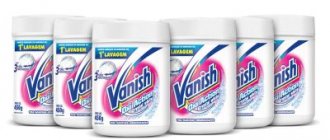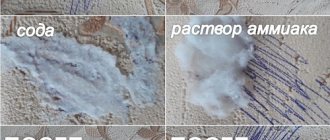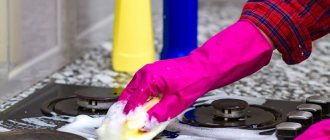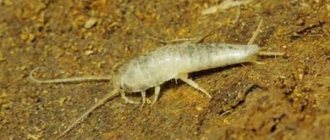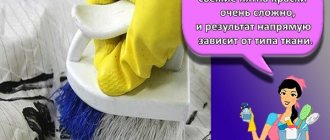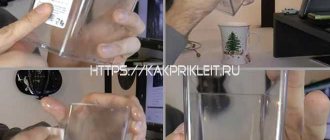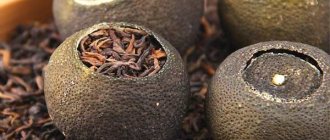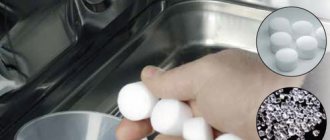A little history
In Ancient Egypt, in order to get beautiful clothes and bed linen, it was customary to bleach cotton. Since there were no chemicals intended for this purpose at that time, this procedure was carried out simply by aging the material under the rays of the sun. Later, other methods of bleaching both raw materials and finished items were used in different countries. Chemicals began to be used for this purpose only at the end of the 19th century. Sodium hypochloride turned out to be the most effective and inexpensive remedy. Compositions intended for whitening are still produced based on it. Including the well-known “Whiteness”, instructions for use of which will be discussed below.
Disinfection with White
The concentrate has not only a whitening, but also an antiseptic effect. Why else is Whiteness needed in everyday life:
- effectively destroys bacteria;
- fights fungus;
- eliminates bad odor in the house;
- cleanses grease and dirt on surfaces.
Whiteness is often used as a disinfectant. You can add the concentrate to water for washing dishes, floors, wiping kitchen tables or refrigerator shelves. Take no more than 50 ml of product per 1 liter of water, place cutlery in the solution, then rinse well with water. It is possible to remove the stench coming from the toilet or sink in one night. It is enough to pour a liter of White into the hole, cover it with a lid or a rag and leave it overnight. In the morning you need to wash off the mixture with water, but the aroma from the antiseptic will remain for several more days. The smell from a cat litter box or rodent cage can be removed by wiping the object with a solution of Whiteness and water (in a ratio of 1:10).
Whiteness is a product used as a bleach and antiseptic. It is used to disinfect water, treat cutlery and bleach fabrics. It is necessary to take into account what Whiteness consists of in order to avoid an allergic reaction.
Universal composition
Of course, this product is mainly used by housewives to whiten clothes. “Whiteness” can also be used to remove stains of almost any origin. The use of this product is quite effective when it is necessary to clean porcelain, earthenware and plastic dishes, as well as tiles, from various types of contaminants. For disinfection (for example, plumbing), housewives also often use “Whiteness”. You can also use it to get rid of unpleasant odors - from the trash can, cat litter, etc.
Chemical properties
Hypochlorites are unstable compounds that easily decompose with the release of oxygen. The decomposition of solid sodium and calcium hypochlorites can be represented by the equations
2NaClO = 2NaCl + O2↑ and 2Сa(ClO)2 = СaCl2 + O2↑.
Processes at room temperature occur slowly, and when heated they can occur explosively. In parallel with reactions accompanied by the formation of chlorides and free oxygen, disproportionation reactions can occur
3NaClO = NaClO3 + 2NaCl and 3Сa(ClO)2 = Ca(ClO3)2 + 2СaCl2.
The decomposition of hypochlorites in aqueous solutions depends on the acidity of the solution and its temperature. In strongly acidic environments at pH ≤ 3, hypochlorous acid decomposes to chlorine and oxygen at room temperature
4HClO = 2Cl2↑ + O2↑ + 2H2O.
If hydrochloric acid is used during acidification or chlorides are present in the solution, oxygen does not form
HClO + HCl = Cl2↑ + H2O.
Hypochlorous acid is very weak, so it can be displaced from a solution of its salts by the action of carbon dioxide
ClO– + CO2 + H2O = HCO3– + HClO.
In slightly acidic and neutral environments at 3 < pH < 7.5, the following redox reaction occurs
2HClO = 2HCl + O2↑.
In neutral and alkaline solutions, a competing reaction of the formation of chlorides and chlorates takes place
3ClO– = ClO3– + 2Cl–.
At room temperature, the disproportionation reaction proceeds slowly, but at temperatures above 70°C this reaction becomes predominant.
In alkaline environments at pH > 7.5, hypochlorite ions predominate in solutions, decomposing as follows:
2ClO– = 2Cl– + O2↑.
Stabilization of hypochlorites in aqueous solutions. Salts of hypochlorous acid are much more stable than the acid itself. With increasing pH, the mole fraction of hypochlorous acid in the solution decreases and thereby the stability of hypochlorites increases (Fig. 1). In the pH range > 11, the content of hypochlorous acid is extremely low, however, even at this acidity, slow decomposition of chlorine(I) compounds is observed. The ongoing reactions can be written as:
2ClO– = ClO2– + Cl–, (1)
ClO2– + ClO– = ClO3– + Cl–, (2)
2ClO– = O2 + 2Cl–. (3)
About 95% of the total amount of hypochlorite ions decomposes as a result of successive reactions (1) and (2), with reaction (1) being the slowest (limiting) and determining the overall rate of the process. Reaction (3) is not the main one, but is responsible for the release of oxygen, the amount of which can be significant.
In the presence of some metal ions, for example, copper, nickel, cobalt, catalytic decomposition of hypochlorite ions is observed. Iron ions have a weak catalytic effect and are cocatalysts in combination with other metal ions. In the simplest case, when the solution contains copper(II) ions at a concentration of 1 mg/kg, the orders of homogeneous reaction for hypochlorite and copper(II) are equal to unity.
Heterogeneous catalysis by metals and their insoluble compounds is complex and poorly reproducible. Of the insoluble catalysts, the greatest interfering effect is exerted by nickel and its oxides, which enter hypochlorite solutions upon contact with alloyed nickel steels used for the manufacture of pipelines and tanks.
The rate constants of reactions (1)-(3) are greatly influenced by the ionic strength of solutions. High electrolyte concentrations reduce reaction rate constants and provide reasonable storage stability for electrolyte solutions. An increase in the concentration of hypochlorite ions, on the contrary, reduces their stability in aqueous solutions. In Fig. Figure 2 shows the phenomenon of the “intersection curve”. Solutions of sodium hypochlorite with a concentration of 9% and 5% decompose during storage so much that after 50 weeks they show the same concentration of the substance, and after 100 weeks the initially more concentrated solution contains less hypochlorite ions than the diluted one.
Rice. 2. Decomposition of sodium hypochlorite of various concentrations at 30°C.
An increase in temperature accelerates the decomposition processes of hypochlorites, so it is advisable to store hypochlorite solutions in a cool place to ensure shelf life (Fig. 3).
Rice. 3. The effect of temperature on the decomposition of a 5% NaClO solution.
To stabilize aqueous solutions of hypochlorites, as well as products based on them, each manufacturer uses its own methods, which are rarely published in the form of articles. However, some patented methods are known, which, without pretending to be complete, can be presented in the following list:
- removal of chloride ions accompanying hypochlorite ions by crystallization;
- preparation of hypochlorous acid, free from chloride ions, by methods of electrodialysis, distillation and liquid extraction, followed by neutralization with alkali;
- addition of polyols (eg galactitol, mannitol, sorbitol, inositol and pentaerythritol);
- addition of amides;
- precipitation and filtration after adding alkaline earth metal compounds;
- adding periodates or periodate-forming compounds capable of forming complexes with metal ions - catalysts for the decomposition of hypochlorites;
- adding silicates with or without additives;
- adding bromides;
- adding arylsulfonamides or derivatives thereof;
- increasing the light resistance of hypochlorites by adding imidodisulfate salts; cerium salts and EDTA; ferricyanides; isocyanuric acid and sodium citrate;
- adding excess ferric chloride followed by filtration;
- adding sodium heptonate or sodium boroheptonate;
- addition of 2-oxazolidinones;
- adding sodium phosphate;
- adding potassium dichromate;
- adding calcium salts;
- addition of polydentate heteroaromatic compounds.
The direction of redox processes involving hypochlorite ions and hypochlorous acid is determined by the values of standard electrode potentials of half-reactions in an aqueous environment:
in an acidic environment
2HClO + 2H+ + 2e– = Cl2↑ + 2H2O, E° = 1.630 V,
HClO + H+ + 2e– = Cl– + H2O, E° = 1.500 V.
in neutral and alkaline environment
ClO– + H2O + 2e– = Cl– + 2OH–, E° = 0.890 V,
2ClO– + 2H2O + 2e– = Cl2↑ + OH–, E° = 0.421 V.
Thus, hypochlorite ions and hypochlorous acid have pronounced oxidizing properties, and their oxidizing ability in an acidic environment is much higher than in neutral and alkaline environments.
“Whiteness”: composition
As already mentioned, the main component of this remedy is sodium hypochloride (NaClO). Active chlorine in “Belizna” contains about 70-85 g/dm3. The concentration of alkaline components is about 7-15 g/dm3 (in terms of NaOH).
In order to increase the wettability of the fabric, special surfactants are added to the solution. This product is a light yellow liquid with a characteristic pungent odor of chlorine. This is one of the disadvantages of Whiteness bleach. Its composition, as you can see, is extremely simple. Even bleach is made from more components. “Whiteness” is usually sold in white or green liter plastic bottles. Today in hardware stores you can also buy a version with a bluing effect.
Methods of use in everyday life
Let’s look at the most popular options for using “Whiteness” for domestic purposes.
Fabric bleaching
Only cotton or linen items can be washed with “Whiteness”, but it is important to remember that with frequent use the structure of the material is destroyed, so you should resort to bleaching as rarely as possible. The most commonly used soaking is:
- Stir 2 tablespoons of the product into 10 liters of water at room temperature.
- Immerse the items in the solution for 15–60 minutes (the duration of soaking depends on the degree of contamination of the items).
- Rinse the fabrics well in running cool water 2-3 times.
- Wash in any way: by hand or in a washing machine.
“Whiteness” will return the dazzling “snowiness” to white things, but only cotton and linen items can be washed with the product
You cannot use too hot water when soaking with “Whiteness”: the fabric will lose its strength very quickly.
Any chlorine bleaches, including “Whiteness,” are prohibited from being used in a washing machine: this can lead to the destruction of parts of the device.
Cleaning surfaces
To clean heavy dirt, remove stains and even mold on walls, floors and white furniture, experienced housewives use “Whiteness”:
- Apply the undiluted product to the dirty or fungal-covered area using a brush or sponge. For delicate surfaces, use a solution: 40–50 ml of product per liter of water.
- Leave for 15–60 minutes; as the stain dries, the stain will lighten.
- Use a stiff brush to treat the cleaned area.
- Rinse with clean water.
Before using the product, you need to test its effect on an inconspicuous area of the surface: in some cases, an aggressive product may leave behind light stains.
“Whiteness” is recommended for cleaning tiles, stone and wooden surfaces, plaster, and ceramics. For paper (wallpaper) and colored fabrics, it is better to arm yourself with a less aggressive product.
Video: removing mold from walls
Disinfection
The bactericidal properties of the product allow the product to be used for disinfection purposes.
For disinfection measures, “Belizna” is diluted with water (see proportions below) and used for washing dishes, floors and walls, plumbing fixtures, etc. After using the product, the cleaned object or area of the room must be rinsed with plenty of clean water.
The con depends on the purpose for which the composition will be used:
- dishes, trash can - 60 ml per 1 liter of water;
- plumbing (toilets, sinks, bathtubs) - 100 ml per 1 liter of water;
- tiles - 50 ml per 1 liter of water;
- floors - 60 ml per 1 liter of water.
“Whiteness” will help a wise housewife return freshness and cleanliness to the bathroom and toilet.
The product is dangerous for acrylic bathtubs: the product corrodes the surface, making it porous.
Hygiene and pet hygiene items
It is recommended to disinfect animal trays once a week with “Belizna”, dissolving the product in water in a ratio of 1 to 10. If the pet went to the toilet in the “wrong place”, you need to wipe away the traces with a product mixed with water in a ratio of 1 to 20.
Cell disinfection is carried out twice a year as follows:
- Dissolve 200 ml of the product in 5 liters of water and pour the composition into a container with a spray bottle.
- Spray the product over the entire surface of the cages, and thoroughly rinse the floor and corners of the cage with the same mixture.
- After 2 hours, rinse the cage thoroughly under a powerful stream of running water. It’s great if you can use a steam generator.
You can let animals and birds into the “house” after the cage has completely dried.
To clean the aquarium decor you need:
- Pour 8–10 liters of warm water into a large container.
- Dissolve 1 liter of “Whiteness” in liquid.
- Immerse decorative elements in the solution for several hours.
- Rinse all items thoroughly with warm running water. Pay special attention to elements with a porous surface: thoroughly shake out all the water from the pores, otherwise the remaining chlorine in them can get into the aquarium and negatively affect its inhabitants.
To disinfect the glass of an aquarium, you need to spray a solution of “Belizna” (50 ml per 1 liter of water) onto its surface using a spray bottle and after a few hours rinse thoroughly with running water.
Video: washing aquarium decor
Pool
Chlorination is most often used to disinfect water in swimming pools. At home, you can use “Whiteness” for this purpose:
- Make sure that the water parameters in the pool are as follows: pH - 7.2–7.6, temperature - 23–32 °C.
- Prepare the required amount of product. For 1 liter of water you will need 1–3 mg of active chlorine.
- Pour the prepared volume of product evenly over the entire area of the pool.
- After 4–5 hours, check the chlorine concentration. The maximum permissible level of active chlorine in water is 0.6 g/m3, the optimal value is 0.3–0.6 g/m3. This indicator is measured by special devices - testers.
Chlorination with Belizna will help keep the water in the pool clean.
It is necessary to look at the label for the percentage of the substance in “Whiteness”; this figure can vary in the range of 2–10%. Determine the amount of active chlorine in the bottle using the formula: volume of container * percentage of substance / 100. For example, a 500 ml bottle of 4% “White” contains 20 g of active chlorine (500*4/100=20).
To prevent such a procedure from causing harm to health, it is important to understand that active chlorine has disinfecting properties, but after reacting with organic substances (algae, skin particles, etc.) it becomes “bound”. This compound is toxic and, in accordance with sanitary standards, water should not contain more than a third of it. Therefore, regular water changes (once a day) and high-quality filtration are necessary.
Greenhouse
High temperature and high humidity create favorable conditions in the greenhouse for the growth and development of pathogenic microorganisms. Therefore, experts recommend disinfecting the structure of the structure and the soil annually; this is usually done in the fall, after harvesting. This measure can significantly reduce the incidence of plant diseases and parasite damage to “pets”.
And in this case, “Whiteness” will help:
- Remove all old vegetation, including roots and weeds, and garter debris.
- Rinse the structures and covering material with a solution of the product (1 part of the product to 20 parts of water).
- Rinse everything with clean water.
When processing polycarbonate, you can only use soft sponges and cloths to avoid scratching the surface.
Sewage cleaning
The following method will help clean and disinfect sewer drains, and at the same time get rid of the unpleasant smell of sewer pipes:
Advantages of the product
“Whiteness” is a bleach that has the following advantages:
- Versatility. Probably every housewife has this popular remedy in case of problems such as stains on clothes, unpleasant odors or dirt containing microbes.
- Effectiveness of action.
- Very low cost. The price of a bottle of Belizna ranges from 18 to 20 rubles. It lasts a long time.
- Ease of use. To whiten clothes, just splash a tablespoon of this product into a bowl of water.
- Availability. You can buy “Whiteness” in absolutely any hardware store or department.
- Can be used when washing in cold water.
Security measures
Careless handling of “Belizna” poses a danger to humans. Its fumes are also very harmful to health.
Given these properties, the following rules must be observed:
- store the product out of the reach of children;
- if liquid gets on the mucous membranes or in the eyes, immediately rinse them with plenty of cool water and consult a doctor;
- When washing, cleaning and disinfecting, protect your hands with gloves;
- When washing plumbing fixtures, wear a protective mask to avoid breathing chlorine vapors;
- It is prohibited to store white near food and medicines.
Disadvantages of Bleach
“Whiteness,” as you can see, has a lot of advantages. However, this method also has disadvantages. Firstly, it has a “killer” smell. Some people associate it with cleanliness. But most are still annoying. Secondly, not too careful handling of laundry. Whiteness should be used in moderation. Otherwise, after several washes, holes will appear on the laundry, especially thin ones.
The disadvantages of the “Belizna” product (instructions for use of which will be given below) include the not very beautiful design of the bottle, and in some cases its not particularly high-quality execution. For example, a screw cap may simply refuse to unscrew. Some bottles also have a hemispherical bottom for some reason. Of course, it will not be possible to put such “Whiteness” on a shelf. Therefore, you have to wrap it in a plastic bag and lay it on its side.
What is whiteness concentrate
The concentrated product has three times more economical consumption. The difference is that the composition is more aggressive and dangerous, therefore it is more often used in the industrial sphere than in everyday life.
According to the instructions for using whiteness, its concentrate is diluted in a ratio of 5 ml per liter of water for preventive cleaning, 6 ml for sanitary washing, and 0.35 ml is required when soaking laundry. In its pure form, it is suitable for breaking through a sink drain: just pour a small amount of gel for 30 minutes.
Most modern household chemicals have a limited spectrum of action, so dozens of bottles accumulate in the house: for dishes, bathrooms, toilets, floors, glass and mirrors, washing clothes, etc. They can easily be replaced by white, since its active substance copes with various contaminants, returns freshness to white things, cleans and disinfects.
The product is effective against scale, soap scum, and grease. In addition, the product has an affordable price and is available in several forms; if safety precautions are followed, it does not pose a threat to others.
“Whiteness”: instructions for use when washing
The product can only be used for white or very light-colored laundry. It “kills” colors instantly. Therefore, after washing with it, your bright clothes will look like faded ones. Also, “Whiteness” cannot be used for silk, leather and wool. It is used mainly to remove stains from linen and cotton items, as well as from some types of fine synthetics. Wool and silk will definitely turn yellow after using this product.
For the best effect, “Whiteness” is not added to the machine, but simply pre-soaked (for about 20 minutes) the laundry in it. In this case, one or two tablespoons will be enough for a ten-liter basin. Do not use very hot water.
Using “Whiteness” in everyday life
The widespread use of the product for household work is explained by its good antibacterial and bleaching properties.
Fighting fungus and mold
Mold on the walls is not a completely harmless phenomenon. Fungal spores spread in the air and tend to cause allergic reactions, runny nose, conjunctivitis, and headaches.
Important! Black mold is the most dangerous to humans.
The fungus easily affects surfaces made of drywall, plaster, wood, and brick.
“Whiteness” helps well against mold on the walls, if you properly prepare its concentrated solution for high-quality disinfection. You need to mix sodium hypochlorite and clean water in equal proportions, mix the liquid well and spray it on the required surfaces using a spray bottle. First, the floor and walls affected by mold should be wiped with a dry cloth to remove dust and surface contaminants. Next, you should wait until the solution dries and reapply it.
If the fungal infections are extensive, you can treat them with an undiluted product. Thanks to the high concentration of chlorine, the product will effectively destroy mold spores.
To avoid the spread of fungus in the future, you need to ensure that the air in the room is not too humid. Mold most often occurs in the bathroom. It is necessary to make sure that the ventilation is working properly, ventilate the bathroom after water procedures and periodically treat the walls with antifungal agents.
Bleaching things
Bleaching things with “Whiteness” is a good way to eliminate the grayish or yellowish tint of fabric. The composition of matter is of great importance. Natural cotton fabrics tolerate processing and even boiling with chlorine best. By soaking yellowed tulle in the “Whiteness” solution, you can return it to its snow-white hue. But you should not wash silk, wool, or leather with products containing chlorine.
Also, bleaches are not used for colored fabrics. If you accidentally drop “White” on such clothes, you will be left with a faded stain that cannot be removed.
To maintain the snow-white shade of things, you need to soak them in a weak solution before washing. For 3 liters of water add 1 tbsp. l. products and leave things for 10-15 minutes. Afterwards, wash them by hand with washing powder and rinse well at least 2 times.
To get rid of old stains of blood, coffee or tea, grayness and yellowness, you should soak for a longer time:
- Dilute 100 ml of product in 10 liters of water;
- completely immerse things in the solution and leave them for 1 hour;
- rinse and wash with powder;
- Rinse the items twice more to remove any remaining detergent from the fabric.
Important! Washing with “Whiteness” is not carried out in hot water, it should be warm or cool. The maximum permissible temperature is 35-36 °C.
Children's clothes should not be treated with chlorine bleach. Children's skin is delicate and thin, and an allergic reaction in the form of itching and red spots can easily appear on it.
After hand washing using chlorine-containing detergents, it is recommended to lubricate the skin of your hands with moisturizer.
"Whiteness" for the washing machine
Using “Whiteness” you can get rid of mold in the washing machine; as a rule, it appears in places with high humidity: on the rubber seals and in the drum.
You can add “Whiteness” to the washing machine only if the manufacturer of household appliances allows the use of chlorine-containing bleaches. Information about this is usually indicated in the operating instructions.
“Whiteness” is an aggressive agent, and in order to cause as little harm as possible to the internal parts of the automatic machine, it is best to pour it directly into the drum, first diluting it with water in the required proportion. To give the fabric a snow-white hue, you will need to dilute 3 tbsp in 1 liter of water. l. facilities.
“Whiteness” in the form of bleaching powder is poured into the washing powder compartment, or pre-dissolved in 1-1.5 liters of water, and then poured into the drum.
Items can be machine washed after pre-soaking them in white.
Machine washing with bleach should also be carried out at low temperatures, not higher than 40 °C, optimally 30 °C.
Cleaning the toilet
On the surface of dirty plumbing there are many microbes, including E. coli and staphylococcus. These microorganisms are dangerous to human health.
It is very important to keep it clean and disinfect it regularly. Here's how to clean a toilet using Whiteness:
- scoop out the maximum amount of liquid;
- Apply the gel generously, distributing it under the headband and in the most contaminated areas;
- cover the toilet with a lid and wait about half an hour;
- rub dirt with a brush or sponge;
- Rinse off white with plenty of water.
You should also treat the seat, tank, and outer surface of the toilet. The product copes well with urinary stones and lime deposits.
Important! The toilet should be cleaned in this way at least once a week.
Hard tap water contributes to rapid contamination of the toilet. It accelerates the formation of limescale. Special tablets that should be placed in the toilet tank will help soften and flavor the water.
Disinfection
Thanks to the properties of active chlorine, the Belizna solution is a powerful disinfectant. You can use it to treat kitchen surfaces after cutting raw meat, wash the walls and floors of the toilet, clean animal cages and cat litter boxes.
To wash the cat litter, you need to dilute 100 ml of gel in 1 liter of water. The solution must be rinsed off well, as its smell can scare away the animal.
“Belizna” can also be used to disinfect sewer drains. 500 ml of gel must be poured into the toilet or sink drain, capped and left overnight. In the morning, wash off the product.
To disinfect tiled floor and wall tiles, you will need to dilute 50 ml of “Whiteness” in 1 liter of water. The surface must be thoroughly wiped, paying special attention to the corners and tile seams. Afterwards, the tiles are washed again, but this time with clean water.
It is recommended to wash the floors in the rooms with a weak solution of “Belizna”, 20 ml of product per 3 liters of water. It should be taken into account that due to frequent use of bleach, the floor covering may become slightly lighter. It is recommended to use the product once every 7-10 days. It will not harm linoleum, stone, tiles, or painted wooden floors. As the final stage of cleaning, the floor should be wiped with a damp cloth soaked in clean water.
Is it possible to wash laminate flooring with “White”?
Even the weakest sodium hypochloride solution is not suitable for cleaning laminate flooring. The chlorine in the composition will damage its outer surface and change the color of the coating.
Laminate flooring requires delicate care. Concentrated acid and alkaline solutions are prohibited for washing it. Do not use products containing ammonia or rough abrasives.
It is best to choose professional cleaning fluids for laminate flooring. They effectively remove dirt, add shine and leave no streaks behind.
Advice! To disinfect laminate flooring, you can use a weak solution of table vinegar.
Is it possible to wash an acrylic bathtub with “White”?
Bathtubs with acrylic coating require special care. To clean and disinfect them, do not use products containing chlorine. It is also dangerous to get gasoline or acetone on the acrylic surface.
Under the influence of aggressive chemicals, acrylic is destroyed and loses its shine. The use of abrasive cleaning products is also not recommended.
To care for acrylic bathtubs, special products with a soft composition are used.
Storage rules
The manufacturer recommends keeping the bottle of “Whiteness” in a dark place.
The air temperature should be room temperature. Do not allow the liquid to freeze. After this, “Whiteness” becomes completely ineffective. Of course, the bottle must be tightly closed. The shelf life of the product is 6-12 months. In the future, it can also be used, but it will be necessary to increase the concentration in the form of a gel. Currently, not only a liquid product can be found on sale. If you wish, you can also buy a bottle of gel-like “Whiteness”. This option costs a little more, but it is also much more convenient to use. The gel base does not allow the sodium hypochloride solution to flow down the surfaces. And therefore, the product is spent much more economically. In addition, various types of fragrances are added to the gel “Whiteness”, which almost completely destroy the unpleasant smell of chlorine.
This is how “Whiteness” is used. Instructions for use are given in this article. Follow safety precautions when using this product, dilute it in the required concentrations, and it will become a good assistant for you when washing and cleaning.
Release forms
One of the main properties of sodium hypochlorite is its good solubility in water. This makes it possible to produce “Whiteness” in liquid form, as well as in the form of gel and tablets. The liquid has been known to everyone since childhood as the main bleaching and disinfectant of our grandmothers. Gel and tablets appeared relatively recently as more convenient for application and dosage.
"Whiteness" gel
The product in gel form is sold in plastic bottles. This consistency helps the active substance stay on the surface being treated longer and not drip off. Accordingly, the gel provides the best results when cleaning plumbing fixtures. The composition of “Belizna-gel” is complex, it includes additional components:
- surface active detergents;
- thickeners;
- rust solvents;
- caustic soda;
- perfume fragrances.
The approximate shelf life of the gel is about a year, and the container must always be firmly closed, otherwise the gel will begin to lose its basic properties. In case of freezing, after defrosting the product retains its properties, you just need to shake it.
"Whiteness" in tablets
The product is also available in the form of large white tablets that must be dissolved in water.
